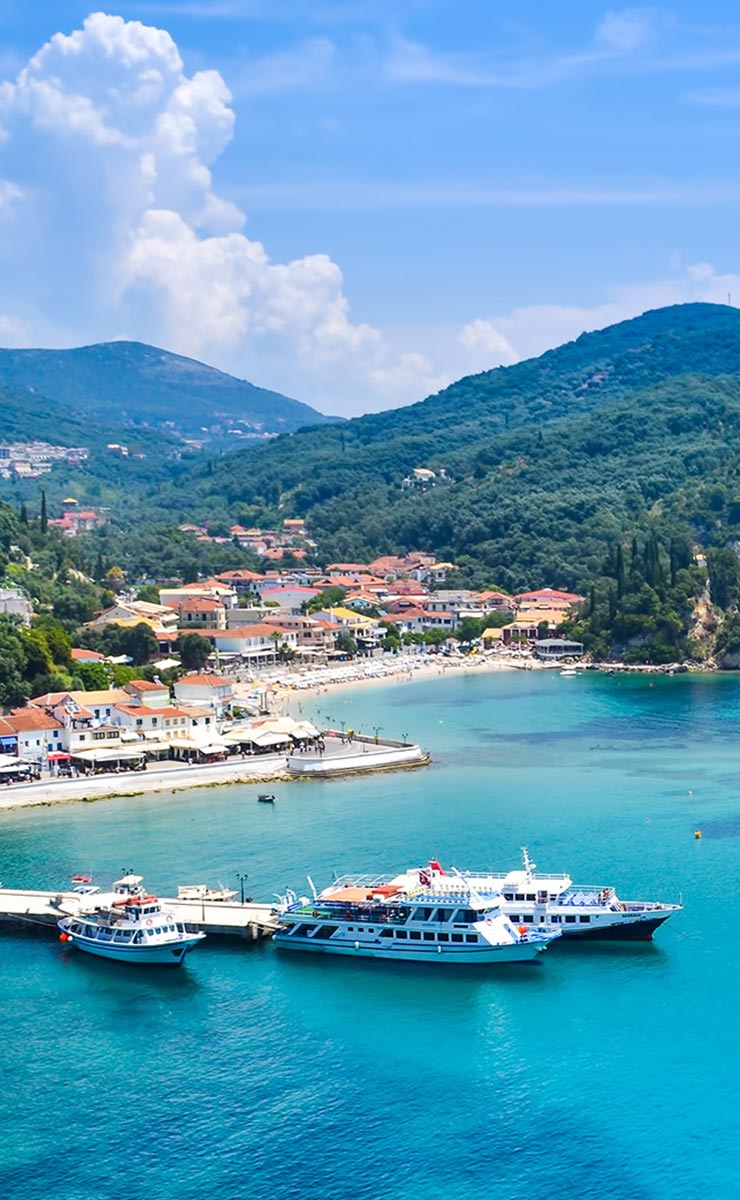Parga sits like a gem on a small, circular bay on the west coast of Greece, just 16 miles (26 km) south and east of Corfu. One of the most picturesque towns on the Ionian sea, Parga's history is relatively short for a Greek town. The area was originally home to the Thesprotians, frequently mentioned in Homer as a Greek tribe friendly with the island kingdom of Ithaca, home of Odysseus (Ulysses), but the town itself wasn't established until the 1360, when the locals relocated the village there from the nearby mountaintop of Mt. Pezovolo, where they had been harassed continually by the neighboring Magebrins. Parga is probably built near the site of the ancient town of Toryne, which is mentioned in Shakespeare's Antony and Cleopatra.
About that time the Normans, who held Corfu, helped the Pargans rebuild a fortress the Pargans had built for protection from pirates as well as neighboring enemies. When the Venetians took over the Ionian islands in 1401, the Pargans came under their authority. Parga had friendly relations with Venice. It was the only free Christian village in the region of Epirus during Ottoman rule.
The French took over the Ionian islands and Parga in 1797, and gave Parga free city status in 1800. In 1815 Parga, in reaction to the defeat of Napoleon, asked for protection from the British, who turned it over to the Ottomans in 1817. Two years later the Pargans voluntarily exiled themselves to Corfu. They had to wait a hundred years for the deliverance of Parga and the Epirus from the Turks after Greece's victory in the Balkan Wars in 1917.
Therefore Parga was one of the few places in Greece which never submitted to the authority of the Ottoman Turks. This, and its succession of ruling entities, gives Parga a cosmopolitan, free spirit atmosphere. Parga is known as the "Bride of Epirus."
Topographically, the town is built on a steep, amphitheatre-like decline from the surrounding hills. It has neat, white, or orange, pink or ochre traditional, 2-3 story houses with pitched, tiled roofs stacked up one behind the other on the rise from the harbor, making Parga a photographer's dream. The Castle, the fortress built on a hill above the town, was originally built in the 11th century (and rebuilt by the Venetians three years later.).
A magnet for summer tourists, Parga boasts beautiful, sandy beaches on the sky-blue Ionian Sea, especially Lichnos Beach, 2.5 miles (4 km) from the town, whose turquoise waters are framed by the greenery of the surrounding vegetation. Lichnos has a small resort, with a few tavernas, cafes, and bars. The beach is a long half-mile (1 km) long. Any place in Greece that is a favorite of Greeks themselves is always a good destination, and Parga attracts its fair share of Greeks.
Parga is a laid-back, take it easy place. There are narrow streets and tiny, family-owned shops selling everything from crafts and souvenirs to basic necessities. I addition to Lichnos Beach, there is the smaller and closer Parga beach, about a five-minute walk from the harbor. Valtos Beach is accessible by boat taxi.
The Vikos National Park (Vikos is the brand name of a well-known Greek mineral water bottled in the area), outside of Parga a short distance, offers splendid hiking trails. Rafting is a favorite water sport on the Acheron River. Boats are also available from Ammoudia village, which will take sightseers to seaside caves, and then explore up the river, which is light-blue in color is places. At one point the river passes between majestic, high, cliffs, There is a lot of wildlife along the river, include several species of birds, including melodic nightingales, and turtles in the river.
The islands of Corfu, Paxos, and Antipaxos are all within easy reach. There is even a coach offering day trips to southern Albania. All in all, Parga has a lot of charm, and is one of the most relaxing, picturesque places in Greece.












